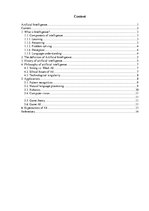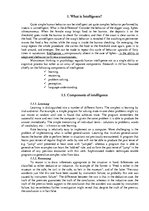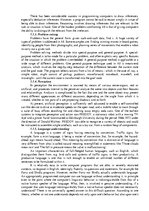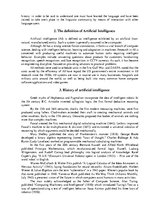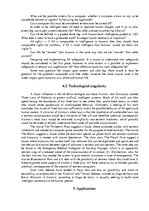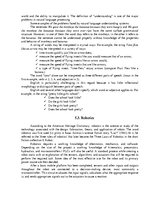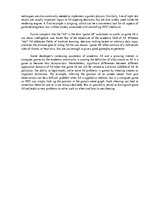-
Artificial Intelligence
| Nr. | Chapter | Page. |
| 1. | What is Intelligence? | 3 |
| 1.1. | Components of intelligence | 3 |
| 1.1.1. | Learning | 3 |
| 1.1.2. | Reasoning | 3 |
| 1.1.3. | Problem-solving | 4 |
| 1.1.4. | Perception | 4 |
| 1.1.5. | Language-understanding | 4 |
| 2. | The definition of Artificial Intelligence | 5 |
| 3. | History of artificial intelligence | 5 |
| 4. | Philosophy of artificial intelligence | 7 |
| 4.1. | Strong vs. Weak AI | 7 |
| 4.2. | Ethical Issues of AI | 7 |
| 4.3. | Technological singularity | 8 |
| 5. | Applications | 8 |
| 5.1. | Pattern recognition | 9 |
| 5.2. | Natural language processing | 9 |
| 5.3. | Robotics | 10 |
| 5.4. | Computer vision | 10 |
| 5.5. | Game theory | 10 |
| 5.6. | Game AI | 11 |
| 6. | Expectations of AI | 12 |
| References | 13 |
Quite simple human behavior can be intelligent yet quite complex behavior performed by insects is unintelligent. What is the difference? Consider the behavior of the digger wasp, Sphex ichneumoneus. When the female wasp brings food to her burrow, she deposits it on the threshold, goes inside the burrow to check for intruders, and then if the coast is clear carries in the food. The unintelligent nature of the wasp's behavior is revealed if the watching experimenter moves the food a few inches while the wasp is inside the burrow checking. On emerging, the wasp repeats the whole procedure: she carries the food to the threshold once again, goes in to look around, and emerges. She can be made to repeat this cycle of behavior upwards of forty times in succession. Intelligence – conspicuously absent in the case of Sphex - is the ability to adapt one's behavior to fit new circumstances.
Mainstream thinking in psychology regards human intelligence not as a single ability or cognitive process but rather as an array of separate components. Research in AI has focussed chiefly on the following components of intelligence: …
Short report about Artificial Intelligence. Definition of AI, AI history and aplications. Noderēs tiem, kas grib iegūt priekštatu par "makslīgo prātu" un tā vēsturi.


